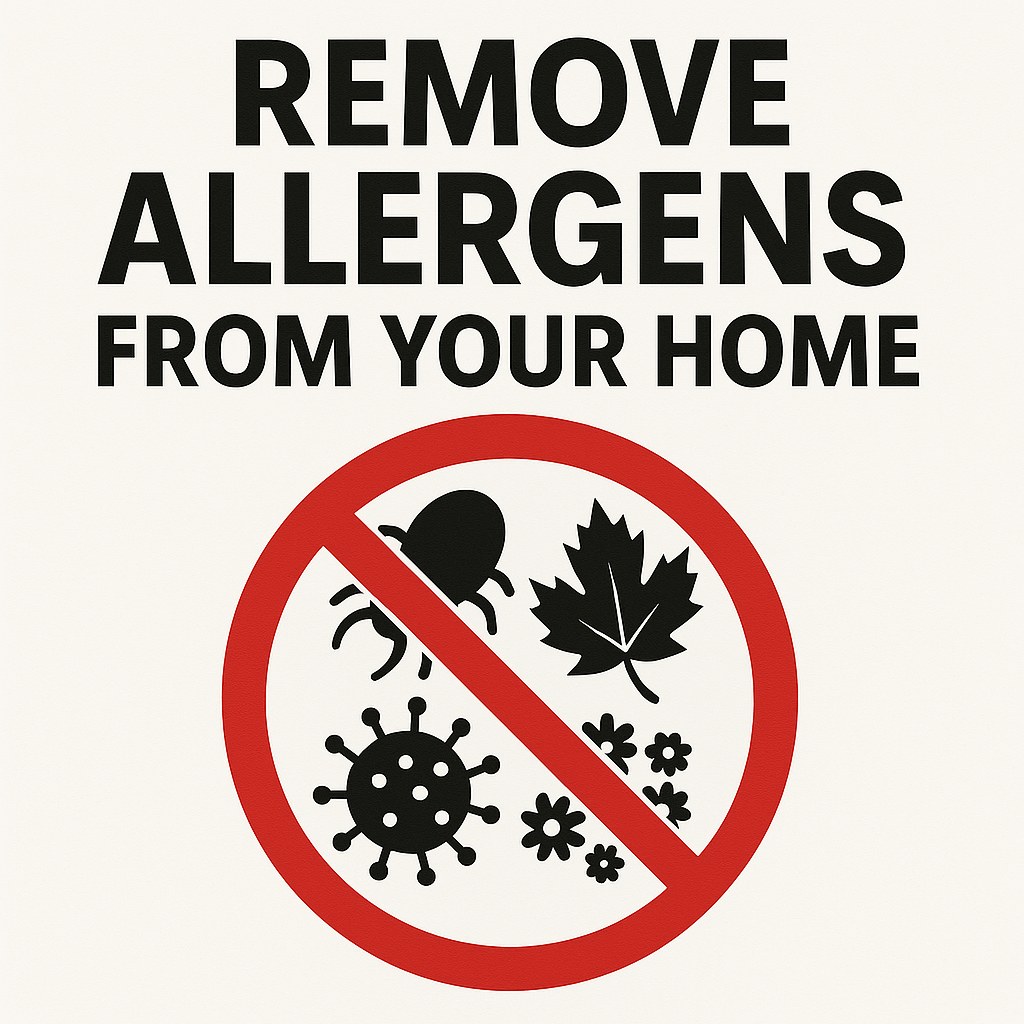How to Remove Allergens From Your Home Effectively
Remove allergens from your home to breathe easier and stay healthier every day. Indoor allergies can be triggered by dust, pet dander, mold, and pollen — all of which easily hide in common household areas. If you or your family members often experience sneezing, itchy eyes, or coughing indoors, it’s time to take action. By learning how to remove allergens from your home, you’ll improve your indoor air quality and create a cleaner, safer space for everyone.
1. Keep Your Home Cool and Dry
Allergens such as mold and dust mites thrive in warm, humid spaces. To combat this, keep your home cool and well-ventilated. In addition, address water leaks promptly, and if needed, use a dehumidifier in particularly damp areas.
2. Control Pests Naturally
Food particles and spills attract insects and rodents. Consequently, store food in sealed containers and clean up immediately after meals. If you notice signs of pests, opt for chemical-free traps. On the other hand, avoid toxic substances if pets or children are around.
3. Close Windows and Use Air Conditioning
If pollen triggers your allergies, it’s best to shut windows during peak pollen hours — especially early morning and late evening. Meanwhile, rely on your HVAC system to keep the air clean and comfortable.
4. Use an Air Purifier With a HEPA Filter
Air purifiers significantly improve air quality. For best results, choose one with a HEPA filter, which can trap up to 99.95% of airborne particles. Furthermore, ensure the purifier suits the room size for optimal effectiveness.
5. Replace Air Filters Regularly
Dirty filters can circulate allergens instead of removing them. Therefore, replace the filters in your HVAC system, purifier, and other units regularly.
6. Replace Carpets With Hard Flooring
Carpets tend to collect dust and moisture. Instead, choose hard flooring like wood, tile, or vinyl. If you prefer rugs, opt for low-pile or washable types. Moreover, wool is a better choice than synthetic fibers, as it naturally resists mold.
7. Remove Shoes and Change Clothes After Being Outside
Shoes and clothing can bring in pollen and other allergens. As a result, it’s wise to create a drop zone near your door for shoes and jackets. Also, wash your face — especially around your eyes — after outdoor activities.
8. Be Cautious With Houseplants
Although houseplants are usually safe, their soil can harbor mold. To prevent this, avoid overwatering and add a layer of gravel to the soil surface. In addition, wipe leaves regularly to reduce dust buildup.
9. Wash Pet Items Frequently
Pet beds, toys, and even fur can carry dander and allergens into your home. Therefore, clean them regularly. If your pet goes outdoors, consider giving them a quick rinse or brushing before they come inside.
10. Clean Regularly and Mindfully
Despite your best efforts, allergens will still find their way in. Therefore, regular cleaning is essential. Use a damp cloth for dusting to avoid spreading particles, and vacuum using a HEPA-filtered or cyclonic vacuum. Additionally, reduce clutter, as it collects dust. When cleaning, it’s also helpful to wear a mask to prevent irritation.
✅ Room-by-Room Guide to Remove Allergens From Your Home
Bedroom
- Keep Pets Out
Your bedroom should be a sanctuary. Hence, make it a pet-free zone to avoid dander accumulation. - Wash Bedding Weekly
Use hot water to eliminate dust mites and allergens. As a result, you’ll sleep more comfortably. - Use Hypoallergenic Bedding
Choose synthetic-filled pillows and dust-mite-proof pillowcases. This simple switch can significantly reduce allergen exposure. - Minimize Fabric Decor
Curtains, throws, and extra pillows collect allergens. Instead, keep these to a minimum to reduce triggers. - Clean Children’s Toys
Children’s bedrooms often contain plush toys. Therefore, wash them frequently in hot water. For chewable toys, ensure they are thoroughly dried after cleaning.
Living Room
- Limit Soft Furnishings
As with the bedroom, soft surfaces increase allergen collection. Consider washable or leather furniture where possible. - Use Washable Curtains
If you like curtains, ensure they are machine-washable — and clean them regularly. Alternatively, use blinds which collect less dust. - Avoid Wood-Burning Stoves
Smoke and ash worsen respiratory issues. Instead, use cleaner heating options such as gas fireplaces.
Bathroom
- Ventilate With Exhaust Fans
Use the fan during and after showers to prevent moisture buildup. This simple habit helps avoid mold growth. - Dry Surfaces Promptly
Mold thrives in wet environments. Therefore, wipe down shower walls and bathtubs after each use. - Avoid Vinyl Shower Curtains
Nylon curtains are more mold-resistant and easier to clean. Moreover, consider replacing old bath mats frequently.
Kitchen
- Clean the Fridge Often
Spoiled food can grow mold. Discard expired items and clean shelves and seals regularly. - Use Exhaust Fans While Cooking
Ventilation removes particles and moisture from cooking. If possible, use back burners to ensure fumes are properly captured. - Cover Garbage Bins
Insects and rodents are attracted to uncovered trash. Hence, use lidded containers and empty them daily. - Wipe Counters and Dry Surfaces
Avoid leaving wet areas on countertops, as they can grow mold. Use a towel to dry surfaces after cleaning.
Basement
- Control Moisture Levels
Basements are prone to dampness. Therefore, install a dehumidifier and ensure proper ventilation. - Store Items in Plastic Bins
Instead of cardboard, use sealed plastic containers. This prevents soft goods from absorbing moisture and developing mold. - Fix Leaks Immediately
Any water entry in basements should be addressed as soon as it’s detected. As a result, you can prevent mold before it starts.
✅ Conclusion: Breathe Easier by Removing Allergens
In conclusion, making your home allergy-friendly isn’t impossible — it just takes consistent effort. By applying these tips to each area of your home, you can remove allergens from your home and enjoy better health and comfort year-round. As a result, your home will become a true safe haven during allergy season and beyond.
